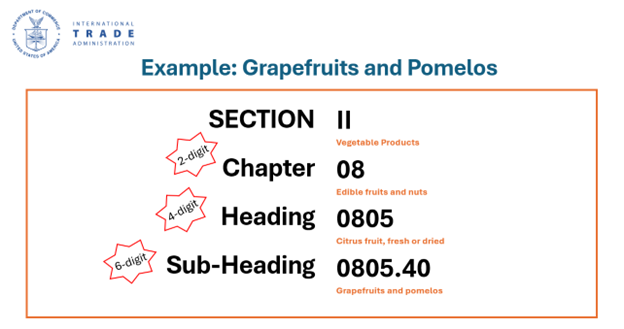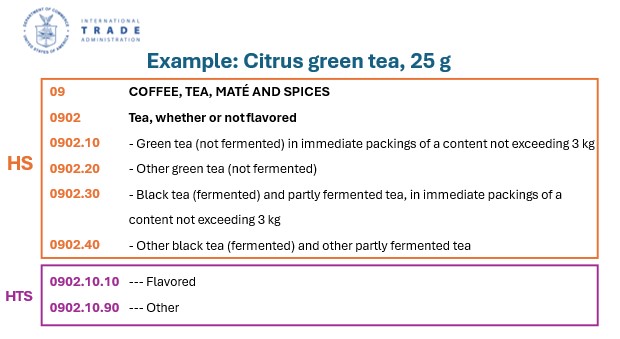An Overview of Harmonized System Codes

June 11, 2025
Isabella Gabriele from the Office of Trade and Economic Analysis
To better organize and understand global goods trade, the World Customs Organization (WCO) developed and administers an international product called the Harmonized System (HS). The HS is a standardized numerical method of classifying traded products. Under the HS, traded goods are classified to a standardized 6-digit level. Applied by more than 200 countries and economies worldwide, the HS is used, among other purposes, to identify products to assess duties and taxes at borders, and to collect trade statistics.
The HS has a hierarchical structure that consists of numerical codes and descriptions of product categories. Each code maps to a goods category and a particular product description. Together, codes and descriptions are called the nomenclature. The nomenclature is updated every five years by the WCO. The WCO presented its latest and overall seventh HS release in 2022. In the nomenclature, there are 21 sections, 96 chapters, over 1,200 headings (commodity groups), and over 5,000 subheadings (product descriptions). Each product is identified by a 6-digit code compromised of one chapter, heading, and subheading. Image 1 provides a visual representation of the structure of the HS nomenclature.
Image 1
The HS is a foundation for the export and import classification systems used by the United States. Around the world countries more narrowly define imported or exported goods by appending digits to HS codes. Therefore, globally standardized 6-digit HS codes can become country specific 8- or 10-digit codes. Like other countries, the United States expands the scope of the HS to the 8- and 10-digit levels. The United States uses 8-digit HS codes to collect tariffs. Exports are classified into roughly 8,000 goods categories under Schedule B, a U.S. Census Bureau publication, and imports are classified into roughly 14,000 goods categories under the Harmonized Tariff Schedule (HTS), a U.S. International Trade Commission publication. Notably, codes and definitions beyond the 6-digit level may vary both across partners and across U.S. exports and imports under Schedule B and HTS. Image 2 includes an example of codes and descriptions which illustrate HS and HTS nomenclature.
Image 2
HS was built to be a universal and adaptive economic language for international goods. International organizations and governments, including the United States, use HS data as a starting point to track goods flow, levy appropriate duties and taxes, create trade policies and monitor restricted goods. HS data can also enable economic research and analysis in areas such as supply and demand, transportation modes, and supply chains. Appropriate classification of traded goods is vital to ensuring an accurate picture of U.S. trade.
At ITA, we work to ensure the success of U.S. businesses by helping them use HS codes to understand domestic and international market opportunities and successfully move products across borders. U.S. trade data arranged by HS code classified data statistics are available through the International Trade Administration.

